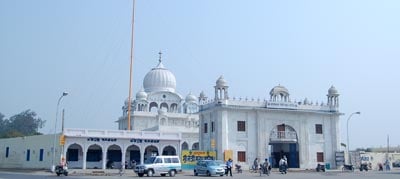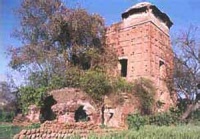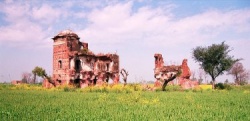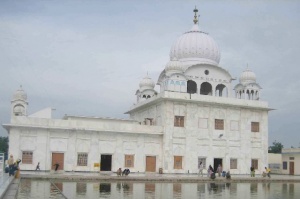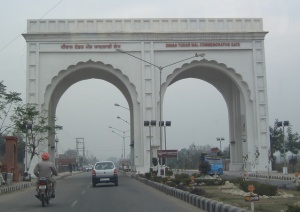Gurdwara Jyoti Saroop: Difference between revisions
Allenwalla (talk | contribs) mNo edit summary |
SinghKalsi (talk | contribs) No edit summary |
||
| Line 14: | Line 14: | ||
At the time of the conquest of Sirhind by Banda Singh Bahadur in 1710 or later by the Dal Khalsa in 1764, no memorial had been raised at this place, so that when Maharaja Karam Singh of Patiala had Gurdwara Fatehgarh Sahib rebuilt, he had to search for and determine the exact spot of the cremation. The urn containing the ashes was at last discovered and he had a gurdwara built over it in 1843 and named it Joti Sarup. A century later, in 1944, Maharaja Yadavinder Singh set up a committee for the improvement of Fatehgarh Sahib and Joti Sarup. The main entrance to the Gurdwara complex was built by [[Maharaja Yadvindra Singh]] of Patiala in 1952 and consequently two upper storeys and a dome were added to the building in 1955. | At the time of the conquest of Sirhind by Banda Singh Bahadur in 1710 or later by the Dal Khalsa in 1764, no memorial had been raised at this place, so that when Maharaja Karam Singh of Patiala had Gurdwara Fatehgarh Sahib rebuilt, he had to search for and determine the exact spot of the cremation. The urn containing the ashes was at last discovered and he had a gurdwara built over it in 1843 and named it Joti Sarup. A century later, in 1944, Maharaja Yadavinder Singh set up a committee for the improvement of Fatehgarh Sahib and Joti Sarup. The main entrance to the Gurdwara complex was built by [[Maharaja Yadvindra Singh]] of Patiala in 1952 and consequently two upper storeys and a dome were added to the building in 1955. | ||
[[Image:Gurudwara_Shri_Jyoti_saroop_Sahib.jpg|thumb|right|300px|Gurdwara Shri Jyoti Saroop]] | [[Image:Gurudwara_Shri_Jyoti_saroop_Sahib.jpg|thumb|right|300px|Gurdwara Shri Jyoti Saroop]] | ||
[[Image:Diwan_Todarmal_Gate.jpg|thumb|left|300px|Diwan Todarmal Gate, one of four gates that surronds Fatehgarh Sahib]] | |||
'''[[Gurdwara Burj Mata Gujri]]''' | '''[[Gurdwara Burj Mata Gujri]]''' | ||
Revision as of 11:04, 4 September 2008
Gurdwara Jyoti Sarup Sahib is situated in the city of Fatehgarh Sahib, Sirhind. It is about a mile to the east of [Gurdwara Fatehgarh Sahib]]. The road connecting the two Gurdwaras is Diwan Todar Mal Marg, along the road one passes through the Diwan Todar Mal commemorative gate. It was on the spot where Gurdwara Jyoti Sarup now stands that Mata Gujri Ji, Sahibzada Zorawar Singh and Sahibzada Fateh Singh were cremated. A former cook of the Guru's household Gangu Ram had not lived up to the codes of conduct concerning guests given shelter. Gangu had taken the Guru's youngest sons and their dadimah (paternal grandmother, Mata Gujri Ji also the widow of Guru Tegh Bahadur, into the safety of his home, after they were separated from the Guru's party during the turbulent crossing of the Sarsa river. Stories usually relate that he was caught stealing from the bag of his guests. Angered and ashamed, he is said to have turned them into the local village Mughal official - hoping for a reward. They were then forced to begin the long treck to Sirhind on foot, but through the intervention of an influentual admirer they were provided with a cart for the journey. Reaching Sirhind they were handed over to Wazir Khan the Viceroy. Thwarted at his attempts to capture the Guru at Anandpur or Chamkaur, he no doubt saw the arrival of the Guru's youngest children as his best chance to regain some favor in the eyes of Aurangzeb. After all he may have thought, how tough could it be to win little children over to Islam.
In Sirhand false charges were made, and ultimately the children were tried. Even though it was winter they were held in the Viceroy's thanda burj (cold tower) which was comfortable only in the heat of summer. Despite offers of worldly power and wealth the young sahibzadas could not be lured to convert to Islam by Wazir Khan. They were first bricked alive into a section of a wall, but this is said to have fallen, sparing their lives. (Today Gurdwara Bhora Sahib contains the section of wall). No doubt angered by this Wazir Khan then had them executed. After the execution, a wealthy devotee of Guru Gobind Singh Ji, Todar Mal, unaware that the Sahibzadas were already martyred tried to win their release from Wazir Khan.
Mata Gujri collapses at word of the Sahibzadas' fate
He went to Mata Gujri Ji and conveyed to her the sad news. Mata Gujri Ji collapsed on the spot and left for her heavenly abode. No doubt, fear of Wazir Khan played a part in the owners of land around Sirhind refusing to sell the wealthy Todar Mall a piece of land on which to hold a proper cremation of Guru ji's family members. But seeing an opportunity to make a small fortune one farmer agreed to sell Todar Mall only enough land on which to perform the last rites of Mata Ji and the Sahibzadas. Finally an agreement was made to secure the tiny bit of land. Todar Mall had to literally 'carpet' the piece of ground in gold coins.
Gurdwara Jyoti Sarup's construction
At the time of the conquest of Sirhind by Banda Singh Bahadur in 1710 or later by the Dal Khalsa in 1764, no memorial had been raised at this place, so that when Maharaja Karam Singh of Patiala had Gurdwara Fatehgarh Sahib rebuilt, he had to search for and determine the exact spot of the cremation. The urn containing the ashes was at last discovered and he had a gurdwara built over it in 1843 and named it Joti Sarup. A century later, in 1944, Maharaja Yadavinder Singh set up a committee for the improvement of Fatehgarh Sahib and Joti Sarup. The main entrance to the Gurdwara complex was built by Maharaja Yadvindra Singh of Patiala in 1952 and consequently two upper storeys and a dome were added to the building in 1955.
When Himmat Singh, a Jodhpur prince, married Princess Shailcndra Kaur of Patiala in 1951, the Maharaja of Jodhpur donated money for the construction of a separate shrine dedicated to the sacred memory of Mata Gujari. This samadh, a small square canopied platform built in white marble, stands in the southwestern corner of the circumambulatory verandah on the ground floor. During the annual Sabha festival, the most dramatic event is a mass procession on 13 Poh taken out from Gurdwara Fatehgarh Sahib and ending at Gurdwara Joti Sarup. At the latter place, Kirtan Sohild and Anandu Sahib are recited followed by supplication in memory of the martyrs. With this the programme officially comes to an end.
Karsewa
Karsewa has been completed on the Main Building, Sarovar Sahib and Darshini Deodi under the supervision of Baba Harbans Singh Ji of Delhi. Karsewa of the Langar Hall is likely to be undertaken to enhance its capacity.
